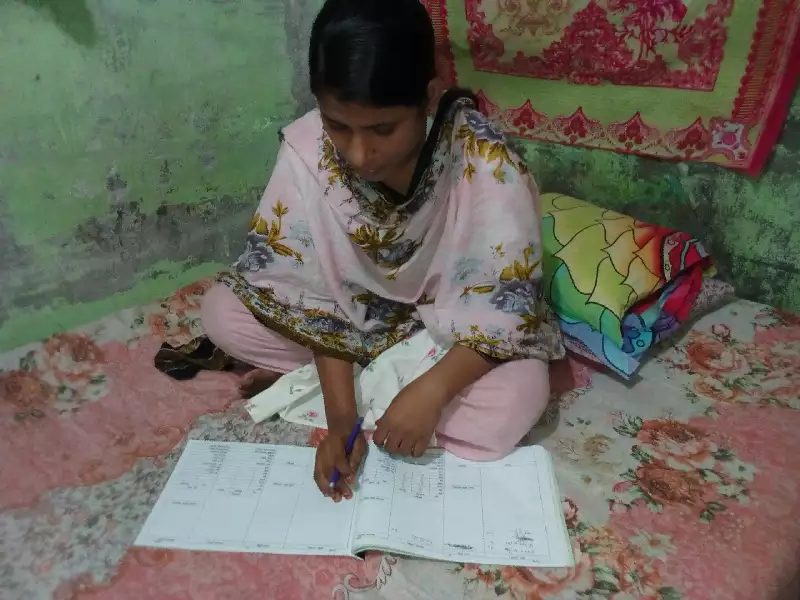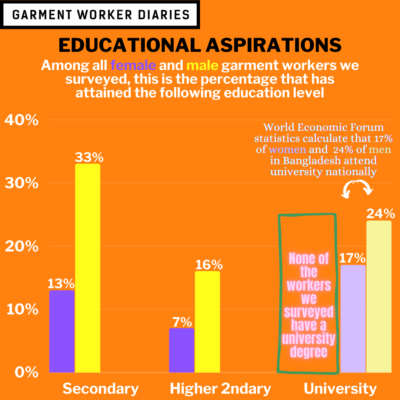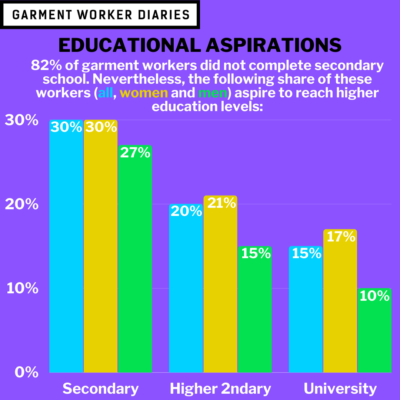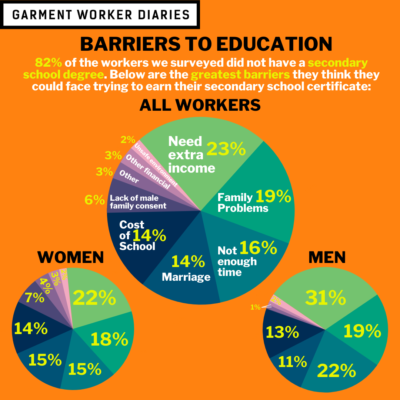Last week we reported on parents’ educational aspirations for their children. This week we focus on workers’ own educational aspirations, and the barriers they face in fulfilling those aspirations. What we learned from the workers, and what you will read below, is that they aspire to getting more education for themselves, all the way up to the university level, highlighting the educational aspiration-reality gap that we identified last week when looking at their kids’ educational aspirations.
Notes: Numbers in graphs may not sum to 100% due to rounding; banner photo of respondent with her financial diary courtesy of a garment worker in Dhaka.
Secondary School
The majority of garment workers we surveyed, 82%, have not attained their secondary school certificate. In the United States, that is the equivalent of not having completed school through the 10th grade. The gender disparity is somewhat wide: 13% of female garment workers have their secondary school certificate, whereas 33% of male garment workers have theirs. This is despite the fact that more adolescent girls than boys are enrolled in secondary education in Bangladesh on the whole, at a rate of 69% to 59%, respectively (according to the World Economic Forum’s Global Gender Gap Report 2020).
For those 18% of respondents who did complete their secondary education, the self-reported barriers to completion were somewhat similar for women and men, but with some important differences. Below is a list of the greatest barriers respondents faced, sorted by frequency of response rate for women and men.
|
Greatest Barrier |
Women |
Greatest Barrier |
Men |
|
Cost of school |
23% |
Need for additional income |
32% |
|
Family problems |
21% |
Family problems |
19% |
|
Need for additional income |
17% |
Cost of school |
18% |
|
Got married |
13% |
Not enough time |
8% |
|
Not enough time |
9% |
Other |
8% |
|
No consent from male family members |
5% |
Other financial problems |
6% |
|
Other |
5% |
Got married |
5% |
|
Not a safe environment |
3% |
Not a safe environment |
4% |
|
Other financial problems |
3% |
No consent from male family members |
1% |
Among the 82% of garment workers who had not completed their secondary education, 30% of them told us they would still like to do so (similar rates for women and men). The perceived barriers to completing their secondary education for this group of respondents were proportionately comparable to the answers from those respondents who had already completed secondary education (represented in the chart above). Perhaps unsurprisingly, those aspiring to complete their secondary education reported not having enough time and getting married as barriers at slightly higher rates (likely because they are older and already have jobs, families and/or other adult concerns), and they reported the cost of school as a barrier at a slightly lower rate, perhaps because they have already saved up money. However, the need for additional income was still perceived as the greatest barrier to completing their secondary education, just as it was overall for those who had already completed their secondary education.
Higher Secondary School
Among the 18% of garment workers who already had completed secondary education, 53% of them had also attained a higher secondary school certificate. In the United States this would be the equivalent of completing the 12th grade. The gap here was narrower between women and men, 55% to 50%, respectively.
Of those 47% of respondents who had completed their secondary education, but had not yet completed higher secondary school there was a bit of an aspirational drop-off: only 41% of those respondents (similar rates for women and men) told us they would like to continue their education and complete higher secondary school.
And among that 30% of aspiring respondents who had not yet completed the first phase of secondary school but would like to someday, 67% of them told us they would also like to complete higher secondary school (69% of women told us they would like to compared to 55% of men).
University
None of the garment workers we surveyed told us they had acquired a university degree, but a number of them would like to. Among those respondents who have completed higher secondary school or who aspire to complete secondary school (374 workers in total), 67% told us they would like to attend university (70% of women compared to 59% of men).
Among both types of respondents (already-educated or highly aspirational), the perceived barriers to completing university were similar to the real or perceived barriers during other educational stages of life, in that the need for additional income and the cost of school were still the two biggest concerns, for both women and men.
Overall, 20% of the garment workers who we interviewed for this survey said they would like to attend university. And for the majority, saving up enough money by working in the garment industry is likely the only chance they’ll have to one day afford a higher education.
All data presented here come from interviews conducted over the phone with a pool of 1,280 workers. These workers are employed in factories spread across the five main industrial areas of Bangladesh (Chittagong, Dhaka City, Gazipur, Narayanganj, and Savar). Just over three-quarters of the working respondents are women, roughly representative of workers in the sector as a whole.



